Nothing, Then Something, Then Nothing: Norma Cole and Sara Wintz in Correspondence

Sara and Norma in 2018.
Norma Cole’s brilliance snuck up on me, a slow-moving line-dance of astonishment. I’m not sure when I met her. I think I might have seen her at Small Press Distribution or talking with friends outside at 21 Grand when I first lived in Oakland. I was just becoming familiar with her work. But I didn’t actually get to know Norma until I lived in New York City, when I invited her to the Segue Reading Series in 2011.
I want to say that she reminds me of my grandmothers, without taking attention away from how cool Norma is, without putting to the side the brilliance of her work. I have always been in a state of wanting to know more, have more connection with my grandmothers, deceased and not, not really knowing how to do that. I think I might be learning how to do that from her.
Norma’s ability to whip out snappy titles (“Facetime,” “I Got Word”) always slays me. She has great taste in eyeglasses. (I think they might be Illesteva, but I’m not sure.) She’s really good at Instagram, which you might not expect. (When she responds to one of my Stories with the animated flame emoji that parades up my screen, I feel way cool.) Years ago, I was on a first date with a professional-gambler-turned-poet. We agreed: “Norma is cool.”
There are lines in Norma’s poems that will never not take my breath away: “Resistance, deep-rooted, time / becomes sight incarnate, embodied / control framing chaos”; “at some point, or at gunpoint / human is to wander / the light is not the usual light / the birds are”; “I want a heart-shaped coffin, said / the song, a guitar shape how it”; “One tries understanding / all translation / rather wants to intersect // to color very carefully / the cypress for example is missing”; “This proves I dreamed.”
There are so many great anecdotes about Norma that I could tell you that supersede all this nostalgia. I hope I’m a little like Norma, when I’m her age. I wanted to know more. We started this correspondence. —SW
Dear Norma,
I’ve always thought of you as the age you are and have been as long as I’ve known you. In conversation, you’ve mentioned early encounters with visual art. (I have this faint recollection of a story about you painting a form on the wall as a child.) Sometimes when I read your earlier works, like Mars, I can imagine what your life was like twenty-five years ago or, when I read Win These Posters and Other Unrelated Prizes Inside, the way you felt about Occupy. These are biographical details that lots of people know: single mom to Jesse, originally from Canada, friendship with Robert Duncan. Once, when we were talking about work and jobs, you mentioned that you chose a career in early childhood education because it’s something that people will always need. (I admire that.) Sometimes, amidst my admiration of you, I find myself trying to string together all of these details, a bit uncertainly, in order to imagine an accurate portrait of your early life. What was it like? When did you learn that you were going to be the cool poet and visual artist you are now?
•
Dear Sara,
I just finished writing the sentence, “After Auschwitz, the poets continue to play ball and write poems.” I’m translating Jean Daive (again) writing about Paul Celan and another poet, this time Ghérasim Luca. I’m writing (in pencil) from the back of the same notebook in which I am writing out the translation (always handwritten, quickly, then first edits typing it into the computer). I’m keeping in mind your question(s) to begin our conversation. You ask me to talk about my “early life,” what it was like. And when did I learn that I would become the poet and visual artist I am now. I never imagined the life I have now. I always was drawing and writing, just as I am right now, sitting at table, pencil in hand. You remember my telling you I drew on a wall. I was older than three — I know that because we’d recently moved from my grandparents’ home to a “house of our own.” It was early morning. Did I not have any paper? Did I want to draw on a larger scale? I can still sort of see that drawing, crayon, a child’s image of “house,” with some trees at the side. And, always, when I think about that drawing, I am astonished that when my mother came downstairs into the living room and saw what I’d done, she didn’t yell at me.
My grandmother, who was born in 1886, in Bristol, England, and came with my grandfather to Canada early in the twentieth century, was always a quietly supportive presence in my life. I was her first grandchild and in my early years we spent time in her kitchen, she preparing meals, I on a chair at the kitchen table, drawing. She always had a supply of grocery-list size blank paper and little pencils, without erasers. Seeing that I “made things” (cut-and-paste collage), she made sure I had her sewing scissors and a saucer of paste she’d make from flour and water.
In kindergarten class, we sat on small chairs in a circle while the teacher read us stories. Once, she looked up from the book she was reading from (someone was coming in the garden gate) and said something like, “The writer had to know whether you push the gate out or pull it in. She needs to remember everything.” I knew already that I was one of those “writers.” Or would become one.
I was brought up to be ordinary, no profession, get married, have children, be “normal.” I tried to be obedient and failed miserably. There was no script to follow. Many missteps later, here I am.
•

Dear Norma,
I just returned to my apartment from the farmer’s market with two bouquets of flowers. There was an end of market special at one of the stalls, two bouquets for $10. I have never seen bouquets so ornate. They are practically rococo! Hm. What’s in them? I’m not sure. I can name a few (snap dragons, zinnias) but the rest are brightly colored mysteries. Like particles from Cai Guo-Qiang’s explosion events; I want to preserve every particle, every petal. What to do? Dry them? The color won’t be nearly so vibrant. Photograph them? Translating it to film, they would lose a dimension. It’s so satisfying to gaze at them on my desk. I want the whole bouquet to exist forever. Memories are so much like this. Every blossom bears the memory of a seed!
I’m imagining you seated at the kitchen table while your grandmother stirred the saucer of flour and water to make paste and that clinking sound from the spoon hitting the interior of the saucer. I like the way that you drew a tinier house on the interior wall of your bigger house. What did your collages look like then? What sorts of papers (magazines, newspapers?) were around the house? It’s funny, the ways that we try to find and adhere to scripts. How much can one’s life be like what’s been written?
•
Dear Sara,
“How much can one’s life be like what’s been written?” you ask. A couple of days after writing “I was brought up to be ordinary […] to be ‘normal,’” I read, “In addition to no longer having bodies women were also expected to be without minds. An American Museum of Natural History exhibition in New York in 1945 described the ideal ‘normal girl’ as one who exuded an ‘air of innocence’ or ‘lovely puzzlement.’” This is from Mary Gabriel’s Ninth Street Women, which I’ve just finished reading. Born in 1945, I grew up with those restrictions, unimaginable today.
A week and a half after your letter, I wonder what you’ve done with the gorgeous bouquets you brought home from the farmers’ market. Where you wrote, “I can name a few […] but the rest are brightly colored mysteries,” I thought immediately of “I don’t know what those flowers are called so I’ll just name their colors: red, mauve, orange.” This is from a piece called “Distraction,” which begins, “When I was young, in Toronto…,” in my most recent book, Fate News. So there are bits about my “early life” there too.
The person who always wanted me to write more “memoirish” stuff was Kevin Killian — look, memo + irish = Kevin. Btw, the Kevin Killian Celebration was held yesterday at SFMOMA, with an overflow crowd. Speakers, songs and a scene from Three on a Match, one of the earliest in the Killian iteration of Poets Theater. The debut of this play was in 1984, at Kiki Gallery, where I played Barbara Steele. (Laurie Reid played her yesterday.) It was the beginning of our ensemble where I got to know many people, a lot of artists whom I would not have met if it weren’t for Kevin, the plays, the way he wrangled us together. In all the plays, I loved being “someone else,” relating as someone else. And getting back to your question about what collage looked like in the early days, it was like that, like being someone else. Little figures moving around in made-up settings.
“What sorts of paper were around the house?” you ask. Life magazine, Time, and the Toronto Star. I first knew about Jackson Pollock and Abstract Expressionism from reading those magazines. And I remember vividly sitting cross-legged under the dining table reading about Adlai Stevenson on the front page of the Star, seeing his photograph and hoping he’d win the presidential election. It was 1952.
Somewhere Cai Guo-Qiang says “Sometimes in life, reality isn’t always ideal, but through my art I find my perfect reality.” I would say through reality I find art. He also says the element of gunpowder is “another type of cure for my childhood.” The cure for childhood is homeopathy, that is, having more of it.
•
Dear Norma,
While I read, “This is from Mary Gabriel’s Ninth Street Women, which I’ve just finished reading,” I was in the process of finishing Richard Cándida Smith’s book, The Modern Moves West: California Artists and Democratic Culture in the Twentieth Century. Smith writes extensively about Jay DeFeo’s paintings and somewhere between pages 77 and 78, he notes, “DeFeo described Origin, and two subsequent paintings, The Veronica, and The Rose, as a triptych exploring ‘floral form’ across a decade,” with “floral form” operating as “an archetypal process of growth — of forming as a process — for which flowers provide one example.” “Forming as a process” must have felt so tangled up with complexity circa 1945, 1952.
I <3 your Kevin recipe: “memo + irish = Kevin.” How I miss his memos. (Emphatic emails; a postcard I received once seemingly out of nowhere.) The cake in everyone’s photos from the Celebration: white (vanilla?) frosting with an edible photo of him smiling mischievously on top, wearing a shirt that said “The Opening of the Field: North American Poetry in the 1960s.” (I have wondered what it tasted like, how it felt to indulge in that cake at that moment.)
Further in Smith’s book he explores the legacy of assemblage in California. I like to think about the connections of early California assemblage to assembly, an assembly of people who materialized there. Modernism, magic, appearance.
How did you decide to move to California? Did you ever live in New York?
Reading Jennifer Szalai’s review of Ninth Street Women in The New York Times (digital); Helen Frankenthaler: “Let the picture lead you where it must go.”

Sara and Norma in 2018.
•
Dear Sara,
Speaking of “assembly, an assembly of people who materialize there,” I am at SFMOMA again, this time for a panel discussion about the artist Jess and his partner, poet Robert Duncan. There’s a lovely show up now, Mythos, Psyche, Eros: Jess and California, and a book just out, The Householders: Robert Duncan and Jess, by Tara McDowell. Tara is going to moderate the panel.
Robert and Jess and the San Francisco poets were the assembly I came to be a part of, to become a part of, although in 1977 I had no idea who I would come to meet. As Helen Frankenthaler said, “Let the picture lead you where it must go.” How did I decide to move to California? The “it,” “the picture” — I didn’t see it until I did but was driven by feel. San Francisco meant City Lights and the city of light where artists and poets assembled.
Now thinking of that time, 1977, and how I got here — (driving from Toronto in a very big old dark green van with a column shift, all our earthly goods in the back except for the boxes of books in storage until we “got here”), never thinking I might not get through the border, let alone be taken from my child — I can’t believe the nowhere that’s now here.
The Bay Area’s temperament at the time was a perfect match for me although it took some time to find my assembly. First I got my son Jesse into an alternative public school, then landed a job at the same school, Second Community School. Right away one of my colleagues, the gay activist Jack “Nick” Latham, became a close friend (and was until he died of AIDS in 1986). Market Street at Civic Center meant the Pride Parade and the Women Against War demonstration. It was also the location of the studio I shared with two other women artists above the now defunct Embassy Theater. My history as a San Franciscan had begun.
And then, by chance, in Berkeley, I overheard two famous poets talking. One said to the other, “I don’t know WHAT Robert Duncan is doing over at New College, talking about Charles Olson and who knows what!” I went to New College the next day, la vita nuova. Eventually, in and around the Poetics Program, I met my core group of friends/poets/artists/filmmakers, and lifelong study.
I walked through the Jess show feeling, well, a little out of sorts — do people even use that term anymore? — mildly irritated because the paintings, the paste ups, and the profusion of materials in the vitrines was stuff I’d always seen in their house being put to use, whereas here it was inert. But hey, people could see it now as opposed to never, I told myself. Then I came up to the fifth floor sculpture garden and café to have a cup of tea and regroup before the panel discussion. No cake this evening.
No Kevin Killian Celebration cake with the fabulous photo of him on it, wearing that t-shirt. Yes, it was a light layer cake, very sweet and delicious. Everyone wanted a piece. He’d have loved it. Eating that cake was a ritual activity, like sitting around a campfire. A few years ago, Kevin had presented me with a box, “for YOU!” I opened it and discovered a t-shirt with Robin Blaser’s picture on it, youthful Robin with a cigarette, looking so debonair, foxy, and charming. North American in the 1960s.
“Forming as a process.” I can look back now and say I came here as a part of the process of my becoming. “Driven by feel” is “forming as a process.” As Barbara Guest has said, “The subject finds itself.”
I never lived in New York, but didn’t you?
•
Dear Norma,
Well, I use the phrase “a little out of sorts” from time to time, though I don’t know if other people do. (And, I’m probably not the very best barometer of normalcy!)
I did live in New York City. But not for very long. Two, maybe three years. I think I may always like cities as they were, rather than as they are. (Does that make sense?) I’ve been listening to Ninth Street Women (the audiobook) at my desk at work ever since you mentioned it. Elaine de Kooning! Now I live in Providence, Rhode Island which is wild and wonderful. I read a long poem about Jay DeFeo’s painting The Rose at a bookstore on Sunday. Sometimes it’s like I’m in three different cities at once.
The Mythos, Psyche, Eros: Jess and California show at SFMOMA looks (in photos) and sounds (in your description) divine. I wish I could go! I empathize with your experience looking through vitrines at SFMOMA. Having lived in that world and experienced it first-hand I can see how it might feel strange to see fragments from it in a museum.
The ways that people value objects; they use them until they can’t or don’t, in an effort to preserve it. In museums, valuable items are not to be touched. We learn so much by touch, we are “Driven by feel.” (I wonder if the paintings, paste-ups, and materials behind glass recognized you and wanted to be accessible to you. I suspect this might have been the case.)

Norma and Sara after their poetry reading at Berkeley Art Museum/Pacific Film Archive, in 2012.
Which reminds me… I want to ask you about Collective Memory. Tell me about the process behind it? How did it feel to invite people into that work? Zooming out (or in) — how do your poetry, translation, and visual art practices intersect?
•
Dear Sara,
Thank you for thinking about Collective Memory, and “the process behind it.” Here’s a little piece that was written for a website, and after that I’ll tell you more about how it felt “to invite people into that work.”
Norma Cole’s Collective Memory was a three-part installation located at the threshold of the exhibition Poetry and its Arts: Bay Area Interactions 1954–2004, curated by San Francisco State University’s Poetry Center Director Steve Dickison, and housed within the California Historical Society on Mission Street in downtown San Francisco from December 10, 2004, through April 16, 2005. Cole’s installation included a site-specific wall sculpture Archives Tableau, a freestanding interactive sculpture House of Hope, whose 426 texts were reproduced on free posters for visitors, and Living Room, circa 1950s, an open library/writer’s room where the artist worked in residency throughout the 17-week run of the exhibit.
Collective Memory was designed to be an open, permeable space that encouraged and relied on interaction with its audience. Cole, along with her assistant, Suzanne Stein, Poetry Center Director and Staff, and numerous volunteers, brought the installation to a point where it could very much develop along its own lines, incorporating many unexpected elements into its life. The audience (students, poets, artists, friends, tourists, neighborhood folks, passers-by) became an integral part of the work. Many of the photographs documented by Cole and others, as well as the 426 texts, and Cole’s notebook sketches for the installations are included in Collective Memory, a limited handmade edition of 48 copies, designed by book-artist Emily McVarish and co-published by the Poetry Center with Granary Books, New York.
It was an invitation to everyone. I wanted people to come see the whole exhibition of Poetry and Its Arts, but also to be able to mingle, share, talk, sit, relax, think. Write, draw. Because one wall was the glass front of the museum, everyone walking by could see into the Living Room. All of a sudden it went from raw space in the front of the museum to looking like a comfortable old-fashioned living room. That is, because of the actual objects (rugs, couch, chairs, bookcases, books — none published after 1960 — , typewriter, phonograph, vinyl records, cushions, afghans, etc.) placed in space, it “remembered” the atmosphere of a cozy setting. I wanted it to feel like that, but at the outset had no idea who, why, or how people would come in. My “role” in the installation was being myself, tending the room, welcoming people, responding to questions. Every week I would put fresh flowers in the vase on the coffee table, that kind of thing.
People I knew came in, students, many classes from universities, high schools, middle or elementary schools, people connected to the exhibition or people who had heard about it came in. And people just passing by from the neighborhood or visiting the city looked and came in. People who were tired, had sore feet with too many packages to carry and needed to sit down, or just wanted to see what the deal was, came in. Tourists walking by with children came in and told the kids what a typewriter was, and then they would type on it. Or play a record on the record player. People would come and chat with whoever was there at the time, for instance…

Stacy Doris and Amy Trachtenberg
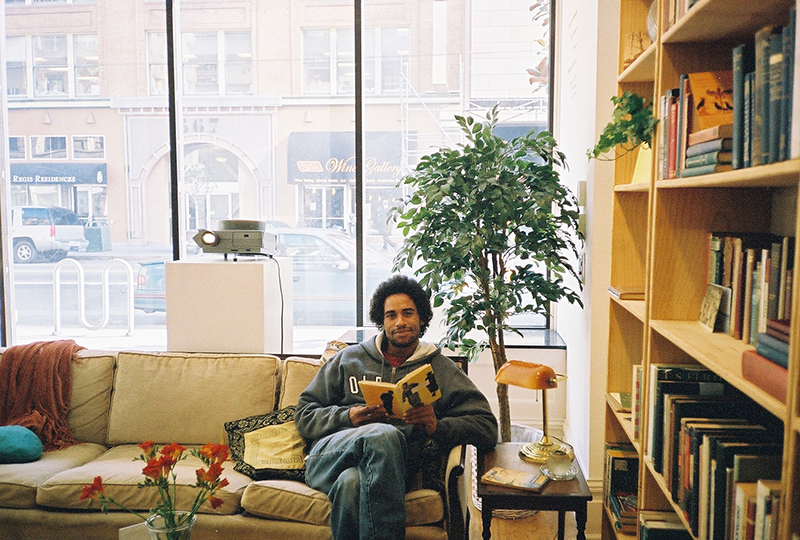
A neighborhood man visited a few times.

Steve Benson, Suzanne Stein, Lauren Shufran, Elise Ficarra, Steve Dickison
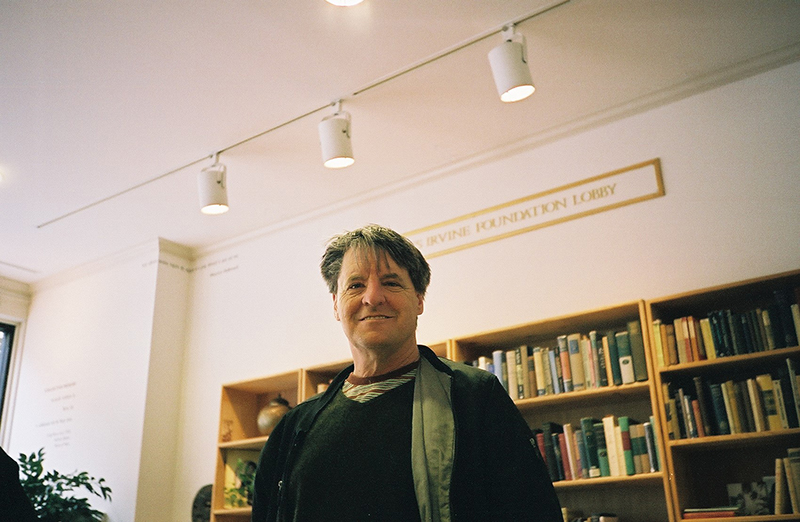
Kevin Killian
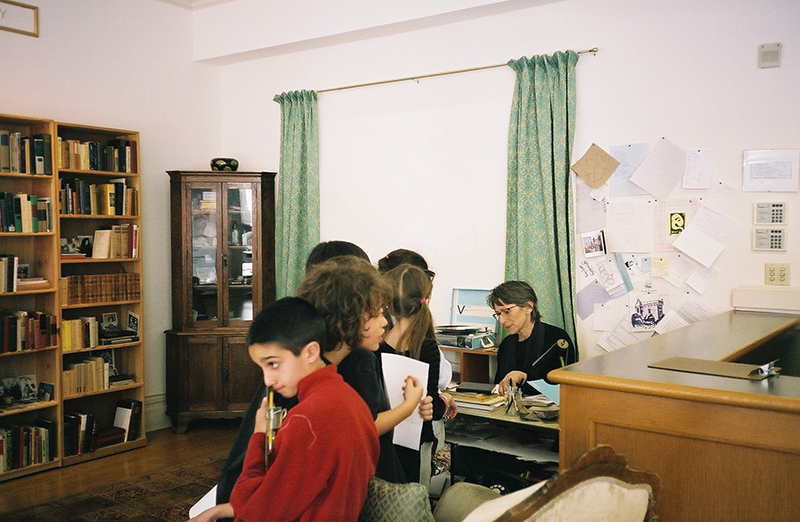
A class of kids wanting me to write something for each of them.
There was also the House of Hope, the freestanding text-sculpture (now hanging in the Poetry Collection Library at the University of Buffalo).
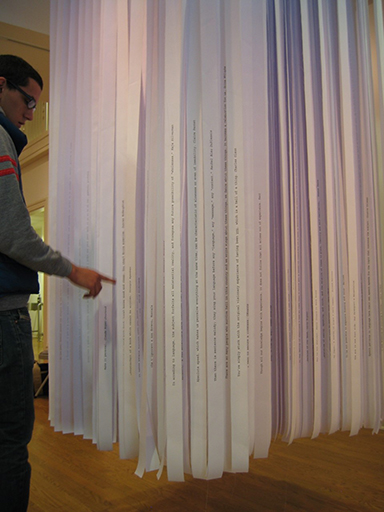
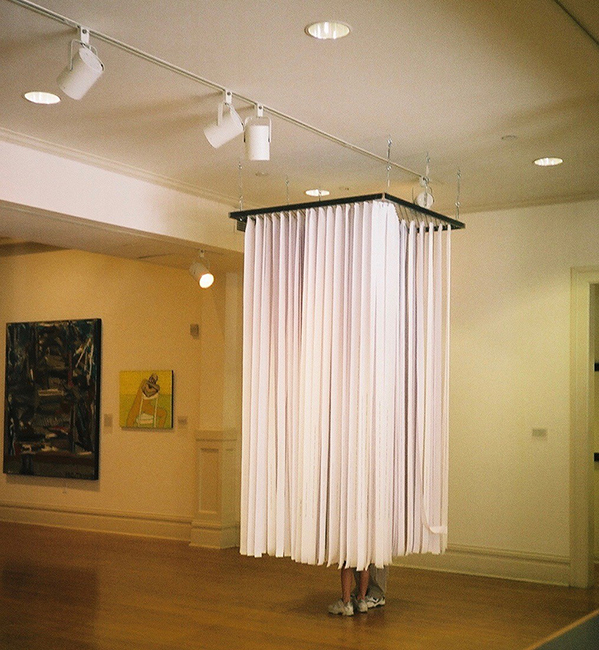
And the posters with the 426 texts reproduced from House of Hope.
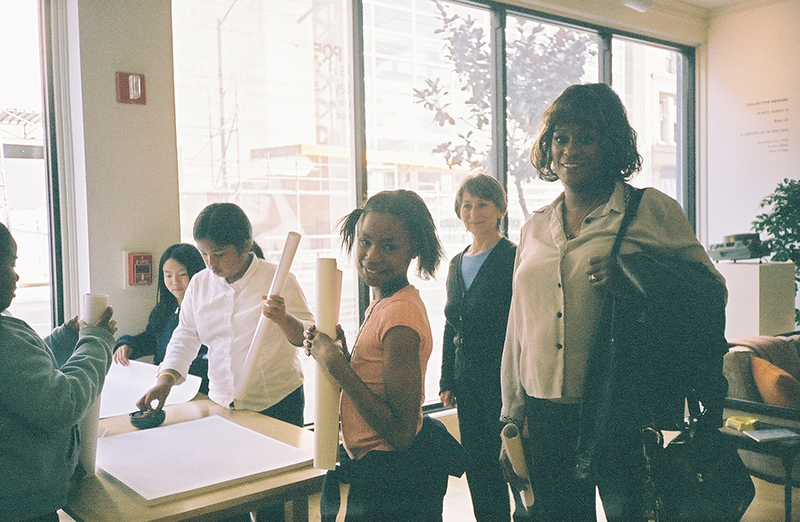
And the Archives Tableau.
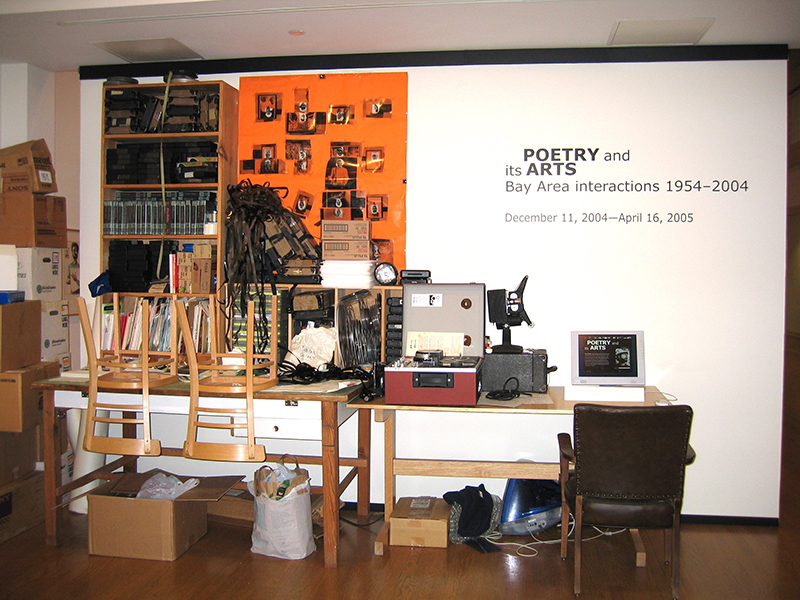
Being interested and curious, I enjoyed every moment. For seventeen weeks, every moment was a surprise. It was a happening thing. You put something together with a lot of breathing space. You didn’t want or need to control everything. It’s a kind of kinesis. And then one day it was all over, the exhibition closed. It was awesome — there was nothing, then something, then nothing.
Collective Memory told me more about how the whole art practice intersects in the moment.
Like my most recent work, a film, By the Turning Bridge (Au Pont tournant) which uses the whole art practice anew: time, space, thought, memory, visuals, audio, composing, transposing, translating, editing, etc. In September (2019) it was looped on a wall monitor in a group show, One of These Things Twice, curated by Margaret Tedesco at NIAD, in Richmond, CA. You can see it here:

At the exhibition’s opening: Norma and By the Turning Bridge.
As you say, like being in different cities at once. The long poem about DeFeo’s The Rose, the one that you read in the bookstore in Providence, was it recorded?
•
Dear Norma,
After reading “It was awesome — there was nothing, then something, then nothing” I dashed out of my office at Brown and hopped into my car to drive to Northampton, Massachusetts. I’m gradually memorizing the details of the two-hour drive from Providence to Northampton, which winds and curls through former industrial cities and towns like Worcester, Ludlow, Wilbraham, and Chicopee via the Massachusetts Turnpike.
I was driving to Zoe Tuck and Brittany Billmeyer-Finn’s home in Northampton, to see Ted Rees, syd staiti, Trisha Low, Cheena Marie Lo, and Stephanie Young read poems in their living room.
One month ago, while driving to Northampton in the middle of a storm, my car skidded on a wet patch of road and grazed the back corner of another vehicle. The driver and I both pulled off to the side of the road and stopped at a nearby Sunoco station to assess the damage and determined that we (and our cars) were both fine.
Now, this weekend, as my gas light illuminated, I had the strange experience of stopping at that very same Sunoco station to fill my tank. I pulled back onto the main road, noticing how it felt to leave the same landmark without incident.
I wonder how living rooms process reunions, goodbyes, extended stays. Does the couch say to the plant “That felt really nice!”? How much do rooms know and remember? I am thinking about the way you said, “Collective Memory told me more about how the whole art practice intersects in the moment.” All of our practices and our histories and our present concerns collided. We weren’t on the West Coast but we could have been there. We all know each other from there, but we converged at a different point on the map, at a different time.

From left to right: Ted Rees, Olive Blackburn, JJ Mull, Sara Wintz, Trisha Low, Zoe Tuck, Cheena Marie Lo, Tessa Micaela, Rebecca Maillet, Syd Staiti, Stephanie Young, Clay Banes, and Brittany Billmeyer-Finn. Pictured in Zoe and Brittany’s living room in Northampton, MA on Friday, October 25, 2019, when Ted, Trisha, Syd, and Stephanie visited from the Bay Area to read from their books. Ted, Olive, JJ, Sara, Cheena, Tessa, Rebecca, Clay, Brittany, and Zoe met in the Bay Area and live constellated across MA, VT, RI, and PA now. Photo by Jay Weingarten.
I don’t think Tom and Emma recorded my reading of the long poem about The Rose. But I’ll put an excerpt of it here:
i was thinking about the rose
a painting that dominated
eight years of jay defeo’s life
from 1958 to 1966, 29 to 37
marriage to divorce. when
complete, it weighed nearly a ton
covering 128 7/8 × 92 1/4 × 11 in.
“can i go see it” “it’s at the whitney”
into the rose, defeo deposited brush strokes
darkness fathom room alone, straddling symmetry
into expression the painter revealed within pattern
strokes her onto that article again and again
in grey oil paint, in speckles of mica
i had become obsessed with it
elevation to status monument, to reframe my sorrow
if one could refer to framed work like that
to reframe sadness like formal concrete
like a work of art created to exhibit
to the dream of appreciative publics
a revelatory fathomless pain
heavy beauty that would wrought death if devalued
if not held up by steel beams, if not placed
into the most artful vessel with care
the rose contains three forms
ridges, aperture, radiating figure
rays extend to canvas edge, she
transformed ridges into petals mid-1959
a year and a half in defeo became dissatisfied
extended rays, expanding size
to a much larger canvas
pulled from one stretcher to a larger one
then leaned it against the bay windows
to block sunlight
i was wondering how we ascribe value to art
without the attached mythology
and wanted to imbue the painting with its story and my own
to re-inscribe the narrative because its narrative held significance to me
a writer who had been toiling on a project for a similar amount of time
how many times did her body move across its surface
to be mutually understood that it was complete
imbued with the kind of wisdom
inanimate objects have after witnessing crime
i was reading “objects reveal forms of expression that bid their users to see,
touch, to feel, and to occupy space in specific and replicable ways.”
meaning built into every book by virtue
meaningful because one can touch, hold it in one’s hands
i wanted to hold onto the language of that
like “we address the contents of art like early stages of utopia”
sentences and lines become beams of wood
to create a tableau with words, magic
the occurrence of the unexpected
art induces extraordinary realities
mostly women attended art academy in california
first to allow women to work from live nude
not philadelphia, not new york, not paris
i was learning the difference between a vocation and a calling
i was wondering if i would ever do one job for the rest of my life
i wasn’t sure what my career was
i was learning how to be sort of okay with being unfinished
It pulls language from a few sources and meshes writers’ words with my own. Some of the fragments are from Richard Cándida Smith’s books, The Modern Moves West: California Artists and Democratic Culture in the Twentieth Century and Utopia and Dissent: Art, Poetry, and Politics in California and Jay DeFeo and The Rose, edited by Jane Green and Leah Levy.
•
Dear Sara,
The photo of everyone in that living room is so moving! And I love the excerpt from your poem, and wanted to ask if you knew Bev Dahlen’s The Rose which was published in one of those beautiful textile series tiny books from little red leaves.
Actually moments ago I was rereading your poem and had stopped at “its narrative held significance to me / a writer who had been toiling on a project for a similar amount of time…”. I looked up from the page and had many thoughts about the “similar amount of time” for both of us, and then began to think about the “amount of time” I’d put into the film I made in August. It happened swiftly in the sense that I didn’t have a film, and then a couple of weeks later I did. But really, in another sense, I’d been making this film since I began making art, both literary and visual, as a very young self.
•
Dear Norma,
Should we stop here?
•
Dear Sara,
I was kind of thinking that too, maybe a good time stop — in midstream. No wind-up, no wind-down.
Comments (1)
This is a moving back and forth between two poets/artists. Thanks for inviting us into the intimacy.
I loved your film, Norma. That majestic moving bridge and boat. I know Norma’s poetry some and will seek out Sara’s.